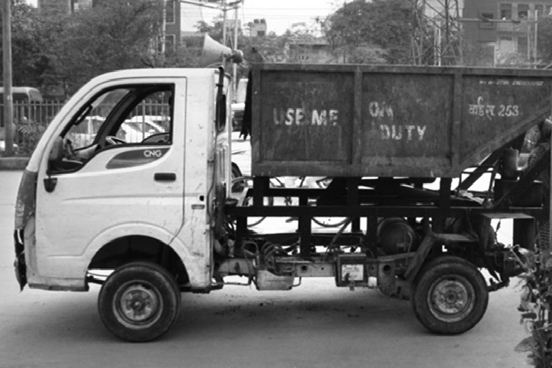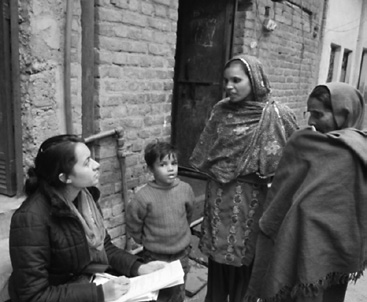
 |
|
 |
|
| Top: Students in the first Sustainable Infrastructure and Sustainable Cities summer school in India interview household members about burning their trash and its effect on their health. Bottom: Students interview waste collectors. The field work was part of a test curriculum Professor Armistead Russell helped develop and test in India and China during the last two summers. A third program in summer 2015 will be in the United States. Russell and his colleagues published a paper on the curriculum in the fall 2014 issue of The Bridge. (Photos Courtesy of The Bridge.) |
A paper outlining a new approach to teaching about sustainability and infrastructure co-authored by Armistead Russell appears in the just-published fall issue of The Bridge, the signature publication of the National Academy of Engineering.
The paper covers the development, implementation and assessment of a new summer course they have delivered over the last two years. It mixes graduate students from China, India and the United States and teaches them about working across cultures and disciplines while also teaching them the principles of sustainable urban systems. The course is part of a National Science Foundation Partnership for International Research and Education grant involving Russell, Professor Michael Bergin, and a number of graduate students to date.
“A lot of people will look at sustainability in terms of the economics, the environment and the social aspects,” said Russell, the Howard T. Tellepsen Chair and Regents professor in the School of Civil and Environmental Engineering. “We look at this as, infrastructure is a huge component of what you can do in terms of sustainability, both the current infrastructure and the infrastructure one’s developing.”
For example, in a country like India, millions of people — mainly women — work in houses where they cook with solid fuels that emit smoke. The smoke leads to respiratory infection and disease, both in the women and in children in the home. The smoke also can lead to heart and lung problems later in life. With a more developed infrastructure, both heating and cooking could use electricity instead.
Such a simple change can vastly improve health, Russell said, while also reducing greenhouse gas emissions
Realizing those impacts is one of the purposes of the Sustainable Infrastructure and Sustainable Cities interdisciplinary education program. That’s why the first summer course took place in India in 2013 and China last summer. Russell and his colleagues are planning a third session in the United States in 2015.
“It was really designed to compare what each of the different areas can pick up from the other areas in terms of what might be beneficial, what can be done, what can’t be done,” Russell said.
The curriculum is also designed to catch students early in their graduate-school careers and establish sustainability as one of their considerations as they’re developing their thesis topics, he said.
“What we want to do is give them a broader appreciation for sustainability and infrastructure in an international context at the beginning,” Russell said. Then they can utilize that to help understand, one, what they want to do, but also, two, how the details of what they’re doing fit into the broader picture.”
In addition to teaching about the concepts of sustainable infrastructure, the program teaches students how do to field research, work in teams, share information across disciplines, and work with people from other cultures.
“Integrated field experiences are a powerful way to link disciplines and promote intercultural and interdisciplinary competence as well as awareness of ethical frameworks and responsibilities,” the authors wrote in the paper.
“Our experience demonstrates that focusing on the learning objectives … in an international, interdisciplinary, blended lecture-fieldwork course can be an effective way to prepare leaders skilled at working in teams across disciplines and national borders to develop environmentally sustainable and healthy cities,” they concluded.
Russell said the outcome of the team’s approach will be even broader as the graduate students develop their own research projects.
“We really do hope to affect the current leadership and environmental directions in these countries, to work with the local cities we are working in to change,” he said. “Maybe within the time period of the project, we [might be able to] propose specific actions that they can take. So it’s not just education and research, it’s trying to have an impact in the shorter term as well.”
